A well-designed kitchen lighting scheme combines different types of lighting to illuminate work areas, set the mood, and enhance the aesthetics of the room. This article will explore kitchen lighting strategies, from task lighting to ambient lighting, to help you create a balance of form and function in your culinary space.
The Right Combo
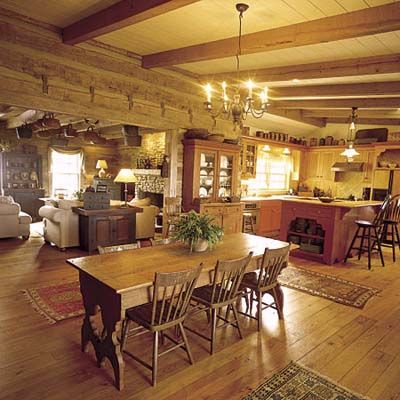
“Contrast is good—it creates drama,” says professional lighting designer Rosemarie L. Allaire, IALD. A successful lighting scheme can be achieved by layering, which consists of mixing various types of fixtures to create a comfortable space. This approach ensures that every area of your kitchen is illuminated for its intended purpose.
In a well-designed kitchen, task lighting is strategically placed over the sink and prep areas to provide focused illumination for activities such as chopping vegetables or washing dishes. For the dining area, a decorative candelabra-style fixture can serve as a source of ambient light and a stylish focal point, creating a warm and inviting atmosphere for meals and gatherings.
Integrating different light sources, such as sconces, ceiling lights, and undercabinet lighting, helps balance overall illumination. This multidimensional approach makes cooking prep easier and adds depth to the kitchen’s ambiance. By selecting fixtures that match your kitchen’s design and personal style, you create a space that’s practical and aesthetically pleasing.
Perfect Pendants
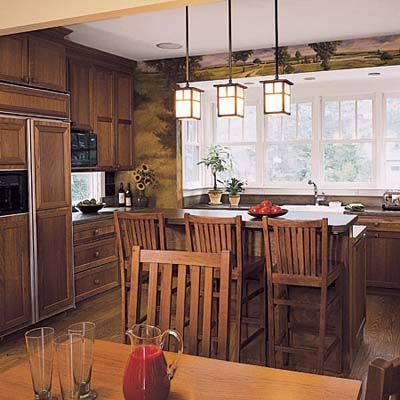
In this example, Craftsman-style pendant lights serve a dual purpose: They provide illumination for food preparation and dining at the island while also acting as a design element that complements the home’s early-20th-century architectural roots.
To enhance the overall lighting scheme, a few recessed fixtures have been added to provide additional task lighting when needed. The large window in this kitchen allows plenty of natural light to flood the space during the day, reducing the need for artificial lighting and creating a bright, airy feel.
Pendant lights come in various styles and materials, allowing homeowners to pick those that blend seamlessly with their kitchen decor. Whether industrial, rustic, or modern, the right pendant lights can elevate the room’s aesthetic while providing essential task lighting.
Undercover Illumination
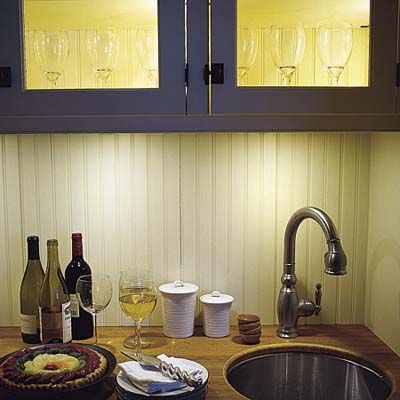
Undercabinet lighting is a discreet yet effective addition to any kitchen. These fixtures illuminate otherwise shadowy counter surfaces, making food preparation easier and safer. In this butler’s pantry, undercabinet fixtures light the countertop workstation.
Another benefit of undercabinet lighting is its ability to showcase attractive glassware or decorative items stored in glass-front cabinets. By illuminating the interior of these cabinets, the lighting creates a beautiful display that also makes it easier to locate items when needed.
Undercabinet lighting can also be used to enhance the visual appeal of backsplashes by highlighting textures and patterns. The right placement and type of undercabinet lights can transform overlooked areas into focal points.
Undercabinet Lighting Options
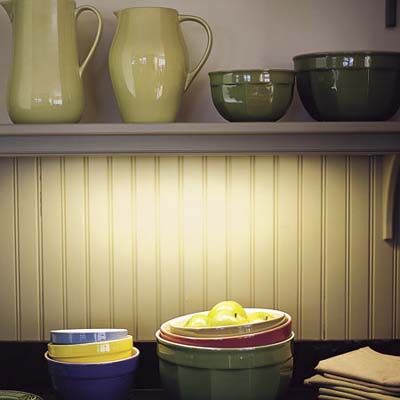
There are three main types of undercabinet lighting you can choose: strip, puck, and mini-track.
- Strip fixtures: These are the most common type of undercabinet lighting. These linear-shaped bulbs provide evenly-diffused, shadowless task lighting across the entire countertop surface. They are ideal for illuminating large areas and ensuring consistent light distribution.
- Puck lights: Also known as disc lights, puck lights cast pools of light onto counters. These fixtures create a softer, more focused illumination that can be aesthetically pleasing but may be less effective for detailed task work. Puck lights are often used to create a more dramatic lighting effect or to highlight specific areas of the countertop.
- Mini-track systems: These systems offer a versatile lighting solution that is easy to install. They consist of miniature low-voltage halogen or xenon bulbs that can be spaced according to your desired effect. This flexibility allows you to customize the lighting to suit your specific needs and preferences.
When selecting undercabinet lighting, consider factors such as ease of installation, energy efficiency, and the specific lighting needs of your kitchen. You can even combine multiple types for a more customized lighting solution that enhances the room’s functionality and style.
Set the Mood
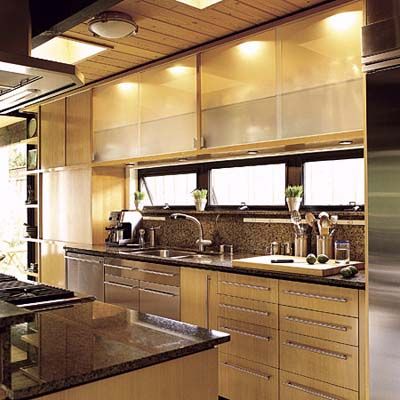
The overall ambiance of a kitchen is greatly influenced by its lighting scheme. In this example, a combination of natural and artificial light sources creates a comfortable and inviting atmosphere. Large glass doors, small skylights, and rectangular windows along the backsplash allow ample natural light to flood the space, reducing the need for artificial lighting during the day.
To complement the natural light, subtle undercabinet puck fixtures have been installed to provide task lighting for countertop work areas. Interior-lit cabinets add a warm glow to the space. For additional task lighting, fixtures have been strategically placed between the skylights, ensuring that every area of the kitchen is well-illuminated when needed.
The balance between natural and artificial light sources can make the kitchen feel welcoming at any time of day. Adjustable dimmers and light colors can further set the mood, adapting the ambiance from bright and energetic during meal prep to soft and relaxed for evening dining.
Design Details
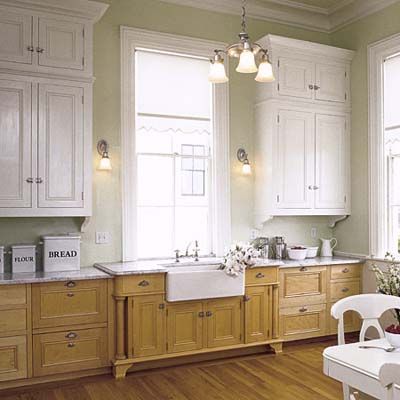
Lighting fixtures can serve as both functional elements and design features in a kitchen. In this example, two matching sconces flank the farmhouse sink, accentuating the pale green walls and creating a focal point in the room.
When selecting lighting fixtures for your kitchen, consider how they will complement your existing decor and color scheme. Choose fixtures that reflect your personal style and enhance the overall design of the room. Integrating unique fixtures such as vintage chandeliers, modern pendant lights, or rustic sconces can add personal character to the space.
Zoning
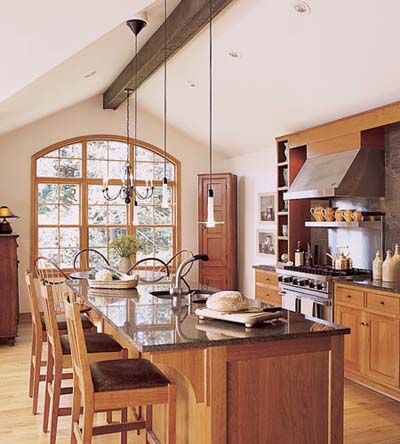
In open-plan kitchens, lighting can define functional areas within the space. This kitchen demonstrates how lighting fixtures can be used to create distinct zones for different activities.
Long, pencil-like pendant lamps are suspended above the island, clearly distinguishing it as a functional work area. These fixtures provide focused task lighting for food preparation and casual dining while also serving as a visual anchor for the space.
In contrast, a candelabra-style fixture hangs over the dining table, setting it apart as a separate eating area. This fixture provides ambient lighting for meals and creates a more formal atmosphere that’s distinct from the working areas of the kitchen.
By using different types of lighting fixtures in each zone, you can create visual separation between areas without the need for physical barriers, maintaining an open flow while clearly defining each functional area.
Green Scheme
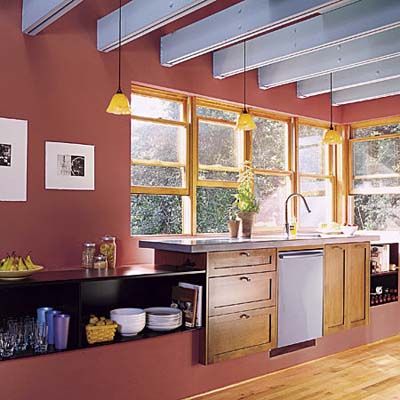
Maximizing natural light in your kitchen can reduce your reliance on artificial lighting, creating a more energy-efficient and environmentally friendly space. Here, a bank of dual-pane, low-e windows allows natural light to flood the space while providing views of the outdoors. The open-plan layout of the kitchen helps distribute this natural light throughout the space, making it the primary light source during daylight hours.
When incorporating large windows or skylights into your kitchen design, Allaire recommends maximum UV protection to prevent interior damage and fading. This will also reduce solar heat gain in the summer. This protection typically comes standard with the glass in new energy-efficient windows, but applying UV-protectant film to existing and vintage windows is also an option.
To enhance energy efficiency, consider integrating daylight sensors or dimming controls that adjust artificial lighting based on natural light availability. This approach minimizes energy consumption, aligns with green living principles, and creates a more sustainable kitchen.
Ceiling Spotlights
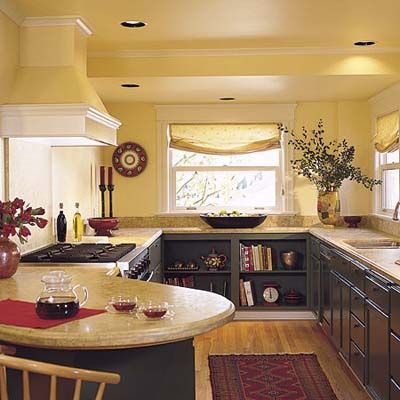
Recessed fixtures, also known as can lights or downlights, are a popular choice for providing general illumination in kitchens. In the kitchen above, recessed fixtures serve as the main source of light, creating a clean and modern look while providing illumination throughout the space.
According to Allaire, halogen low-voltage recessed downlights are a top request from homeowners. “Most people are fascinated and intrigued with halogen, although it’s a technology that has been developed for decades,” she explains. These fixtures offer bright, focused light that can be directed where it’s needed most.
When incorporating recessed lighting into your kitchen, consider using a combination of fixed and adjustable fixtures. Fixed fixtures can provide general illumination, while adjustable fixtures allow you to direct light to specific areas as needed, such as countertops or cooking surfaces.
Time Travel
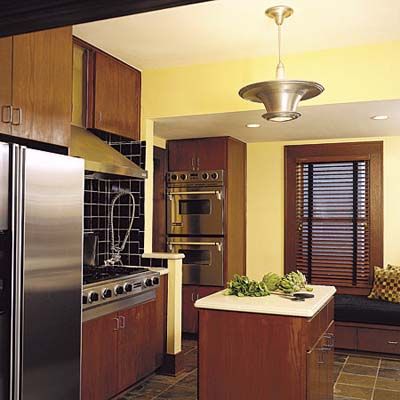
Lighting fixtures can serve as a bridge between different design eras, helping to integrate modern elements with a home’s historical roots. In this kitchen, a vintage-inspired light fixture from the 1920s has been placed over the island, providing task lighting while also paying homage to the home’s original era.
By incorporating period-appropriate lighting fixtures, you can create a sense of continuity between your kitchen’s modern amenities and its historical context. This approach allows you to enjoy the benefits of contemporary kitchen design while maintaining a connection to your home’s architectural heritage.
When selecting vintage-inspired fixtures, look for high-quality reproductions or restored antiques that meet modern safety and energy efficiency standards. This ensures that your lighting is aesthetically pleasing, functional, and safe for everyday use.
